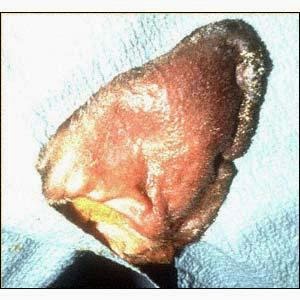Aural hematoma is an accumulation of blood within the cartilage layers of the ear. They usually appear as fluid-filled swellings on the concave (underneath) surface of the pinna, which is the pointed or floppy portion of the ear. The exact cause is poorly understood but any condition that leads to head shaking or ear scratching such as bacterial ear infection or ear mites may be responsible.
Aural hematomas can be painful to the touch and may aggravate an underlying ear disease. Left untreated, the swelling may eventually resolve on its own, leaving the ear deformed, a so-called "cauliflower ear."
What to Watch For
Swelling of the pinna
Diagnosis
On physical examination, a warm, fluid-filled swelling is noted on the inner surface of the ear. Eventually, the hematoma may become firm and thickened, resulting in a deformed "cauliflower" appearance.
Concurrent ear disease like infection or foreign material is common, but not always present.
Radiographs of the skull may be indicated if your veterinarian suspects external or middle ear disease is present.
Evaluation of the ear may show bacteria, yeast, ear mites, or foreign material to be present. Abnormalities in laboratory tests (blood work) are uncommon.
Treatment
The underlying ear disease must be treated appropriately.
Needle aspiration of the hematoma usually resolves the problem only temporarily. Recurrence is common with this technique.
Surgical treatment is usually indicated.
Home Care and Prevention
Take your pet to a veterinarian to have the hematoma evaluated and to determine whether there is any underlying ear disease.
Delaying treatment will rarely result in a satisfactory or cosmetic outcome and fails to address the reason why the hematoma occurred in the first place.
Check your pet's ears frequently, at least once a week, for evidence of inflammation such as redness, swelling or pain.











0 comments:
Post a Comment